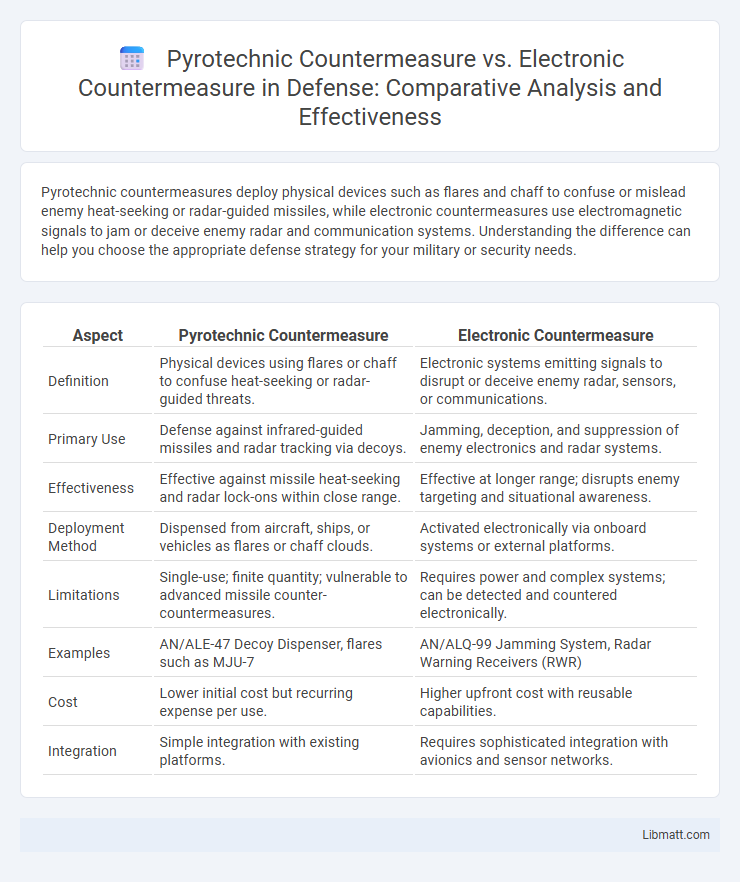Pyrotechnic countermeasures deploy physical devices such as flares and chaff to confuse or mislead enemy heat-seeking or radar-guided missiles, while electronic countermeasures use electromagnetic signals to jam or deceive enemy radar and communication systems. Understanding the difference can help you choose the appropriate defense strategy for your military or security needs.
Table of Comparison
| Aspect | Pyrotechnic Countermeasure | Electronic Countermeasure |
|---|---|---|
| Definition | Physical devices using flares or chaff to confuse heat-seeking or radar-guided threats. | Electronic systems emitting signals to disrupt or deceive enemy radar, sensors, or communications. |
| Primary Use | Defense against infrared-guided missiles and radar tracking via decoys. | Jamming, deception, and suppression of enemy electronics and radar systems. |
| Effectiveness | Effective against missile heat-seeking and radar lock-ons within close range. | Effective at longer range; disrupts enemy targeting and situational awareness. |
| Deployment Method | Dispensed from aircraft, ships, or vehicles as flares or chaff clouds. | Activated electronically via onboard systems or external platforms. |
| Limitations | Single-use; finite quantity; vulnerable to advanced missile counter-countermeasures. | Requires power and complex systems; can be detected and countered electronically. |
| Examples | AN/ALE-47 Decoy Dispenser, flares such as MJU-7 | AN/ALQ-99 Jamming System, Radar Warning Receivers (RWR) |
| Cost | Lower initial cost but recurring expense per use. | Higher upfront cost with reusable capabilities. |
| Integration | Simple integration with existing platforms. | Requires sophisticated integration with avionics and sensor networks. |
Introduction to Countermeasure Technologies
Pyrotechnic countermeasures use physical releases of flares or chaff to divert heat-seeking or radar-guided missiles by creating false targets. Electronic countermeasures employ sophisticated signal jamming and deception techniques to disrupt or confuse the enemy's radar and targeting systems. Understanding these technologies helps you select the most effective defense based on threat type and operational environment.
Understanding Pyrotechnic Countermeasures
Pyrotechnic countermeasures deploy flares or chaff to confuse or decoy heat-seeking or radar-guided missiles, creating physical distractions that protect aircraft and vehicles. Unlike electronic countermeasures that disrupt enemy radar signals through electronic jamming or deception, pyrotechnic methods rely on visible or infrared signatures to mislead incoming threats. Understanding pyrotechnic countermeasures helps you evaluate their effectiveness in environments where electronic interference may be limited or ineffective.
Overview of Electronic Countermeasures
Electronic countermeasures (ECM) use advanced technology to disrupt or deceive enemy radar, communication, and guidance systems by emitting jamming signals or deploying cyber tactics. Unlike pyrotechnic countermeasures, which rely on physical decoys such as flares or chaff to mislead heat-seeking or radar-guided missiles, ECM can target multiple threat vectors including radar frequency manipulation and signal spoofing. You should consider the strategic advantages of ECM when securing assets against sophisticated electronic detection and targeting systems.
Key Differences Between Pyrotechnic and Electronic Methods
Pyrotechnic countermeasures deploy physical flares or chaff to confuse or physically decoy incoming missile seekers, relying on thermal or radar signature manipulation. Electronic countermeasures use sophisticated signal jamming, spoofing, or radar interference to disrupt missile guidance systems without direct physical deployment. The key difference lies in pyrotechnic methods' reliance on expendable, physical decoys versus electronic countermeasures' non-kinetic, signal-based deception tactics.
Applications in Modern Warfare
Pyrotechnic countermeasures deploy flares and chaff to mislead infrared and radar-guided missiles, crucial for protecting aircraft, naval vessels, and ground vehicles in high-threat environments. Electronic countermeasures (ECM) disrupt enemy radar, communications, and targeting systems through jamming and spoofing techniques, enhancing situational awareness and survivability during complex missions. Your choice between pyrotechnic and electronic countermeasures depends on the specific threat profile and mission requirements in modern warfare scenarios.
Advantages of Pyrotechnic Countermeasures
Pyrotechnic countermeasures offer rapid deployment and high-intensity visual and infrared signatures that effectively deceive heat-seeking missiles, ensuring immediate threat neutralization. Their autonomous operation requires minimal electronic input, reducing vulnerability to cyber-attacks and electronic jamming. These countermeasures are lightweight, cost-effective, and provide reliable performance in diverse combat environments where electronic interference might limit the effectiveness of electronic countermeasures.
Benefits of Electronic Countermeasures
Electronic Countermeasures (ECM) provide precise and adaptive defense against radar-guided threats by disrupting or deceiving enemy detection systems, enhancing your platform's survivability without revealing its position. Unlike pyrotechnic countermeasures, ECM can be electronically controlled and updated to address evolving threats, ensuring long-term effectiveness and operational flexibility. These systems reduce collateral damage and the need for expendable materials, making them a cost-efficient and environmentally sustainable choice for modern defense.
Limitations and Challenges of Both Approaches
Pyrotechnic countermeasures face limitations such as finite deployment capacity and the risk of collateral damage due to the physical nature of flares and chaff. Electronic countermeasures (ECM) encounter challenges like susceptibility to signal jamming, reliance on complex electronic systems, and potential enemy adaptation to stealth or frequency changes. Your choice between pyrotechnic and electronic solutions must consider these operational constraints and the evolving threat environment.
Future Trends in Countermeasure Development
Future trends in countermeasure development emphasize the integration of pyrotechnic countermeasures with sophisticated electronic countermeasure systems to enhance defense against evolving threats. Advances in sensor technology and artificial intelligence enable more precise threat detection and adaptive responses, improving the effectiveness of both flare-based and electronic jamming techniques. Your ability to deploy combined countermeasure strategies will become increasingly critical in countering advanced missile guidance systems and electronic warfare tactics.
Choosing the Right Countermeasure Strategy
Selecting the appropriate countermeasure strategy depends on the specific threat environment and mission objectives. Pyrotechnic countermeasures, such as flares and chaff, effectively disrupt infrared and radar-guided missiles by creating false targets, ideal for close-range defense scenarios. Electronic countermeasures utilize jamming and deception techniques to interfere with enemy sensors and communications, providing a broader, adaptable protection against diverse and long-range threats.
pyrotechnic countermeasure vs electronic countermeasure Infographic

 libmatt.com
libmatt.com